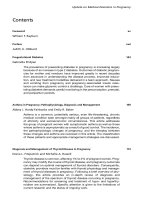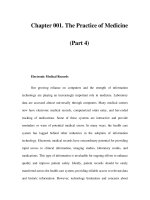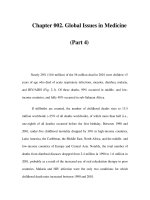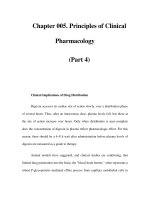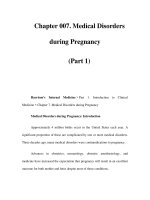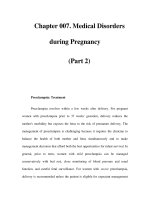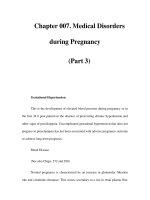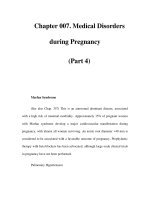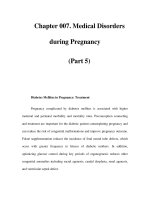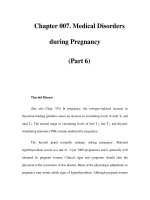Chapter 007. Medical Disorders during Pregnancy (Part 4) ppsx
Bạn đang xem bản rút gọn của tài liệu. Xem và tải ngay bản đầy đủ của tài liệu tại đây (11.33 KB, 4 trang )
Chapter 007. Medical Disorders
during Pregnancy
(Part 4)
Marfan Syndrome
(See also Chap. 357) This is an autosomal dominant disease, associated
with a high risk of maternal morbidity. Approximately 15% of pregnant women
with Marfan syndrome develop a major cardiovascular manifestation during
pregnancy, with almost all women surviving. An aortic root diameter <40 mm is
considered to be associated with a favorable outcome of pregnancy. Prophylactic
therapy with beta blockers has been advocated, although large-scale clinical trials
in pregnancy have not been performed.
Pulmonary Hypertension
(See also Chap. 244) Maternal mortality in the setting of severe pulmonary
hypertension is high, and primary pulmonary hypertension is a contraindication to
pregnancy. Termination of pregnancy may be advisable in these circumstances to
preserve the life of the mother. In the Eisenmenger syndrome, i.e., the
combination of pulmonary hypertension with right-to-left shunting due to
congenital abnormalities (Chap. 229), maternal and fetal death occur frequently.
Systemic hypotension may occur after blood loss, prolonged Valsalva maneuver,
or regional anesthesia; sudden death secondary to hypotension is a dreaded
complication. Management of these patients is challenging, and invasive
hemodynamic monitoring during labor and delivery is generally recommended.
In patients with pulmonary hypertension, vaginal delivery is less stressful
hemodynamically than cesarean section, which should be reserved for accepted
obstetric indications.
Deep Venous Thrombosis and Pulmonary Embolism
(See also Chap. 256)
A hypercoagulable state is characteristic of pregnancy, and deep venous
thrombosis (DVT) occurs in about 1 in 2000 pregnancies. Pulmonary embolism is
one of the most common causes of maternal death in the United States. In
pregnant women, DVT occurs much more commonly in the left leg than in the
right leg, due to the compression of the left iliac vein by the iliac artery and the
uterus. Activated protein C resistance caused by the factor V Leiden mutation
increases the risk for DVT and pulmonary embolism during pregnancy.
Approximately 25% of women with DVT during pregnancy carry the factor V
Leiden allele. The presence of the factor V Leiden mutation also increases the risk
for severe preeclampsia. Additional genetic mutations associated with DVT during
pregnancy include the prothrombin G20210A mutation (heterozygotes and
homozygotes) and the methylenetetrahydrofolate reductase C677T mutation
(homozygotes).
Deep Venous Thrombosis: Treatment
Aggressive diagnosis and management of DVT and suspected pulmonary
embolism optimize the outcome for mother and fetus. In general, all diagnostic
and therapeutic modalities afforded the nonpregnant patient should be utilized in
pregnancy. Anticoagulant therapy with low-molecular-weight heparin (LMWH) or
unfractionated heparin is indicated in pregnant women with DVT. LMWH may be
associated with an increased risk of epidural hematoma in women receiving an
epidural anesthetic in labor. One approach to this problem is to switch from
LMWH to unfractionated heparin before the anticipated delivery date. Warfarin
therapy is contraindicated in the first trimester due to its association with fetal
chondrodysplasia punctata. In the second and third trimesters, warfarin may cause
fetal optic atrophy and mental retardation. When DVT occurs in the postpartum
period, LMWH therapy for 7–10 days may be followed by warfarin therapy for 3–
6 months. Warfarin is not contraindicated in breast-feeding women.
Endocrine Disorders
Diabetes Mellitus
(See also Chap. 338) In pregnancy, the fetoplacental unit induces major
metabolic changes, the purpose of which is to shunt glucose and amino acids to
the fetus while the mother uses ketones and triglycerides to fuel her metabolic
needs. These metabolic changes are accompanied by maternal insulin resistance,
caused in part by placental production of steroids, a growth hormone variant, and
placental lactogen. Although pregnancy has been referred to as a state of
"accelerated starvation," it is better characterized as "accelerated ketosis." In
pregnancy, after an overnight fast, plasma glucose is lower by 0.8–1.1 mmol/L
(15–20 mg/dL) than in the nonpregnant state. This is due to the use of glucose by
the fetus. In early pregnancy, fasting may result in circulating glucose
concentrations in the range of 2.2 mmol/L (40 mg/dL) and may be associated with
symptoms of hypoglycemia. In contrast to the decrease in maternal glucose
concentration, plasma hydroxybutyrate and acetoacetate levels rise to two to four
times normal after a fast.
